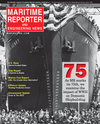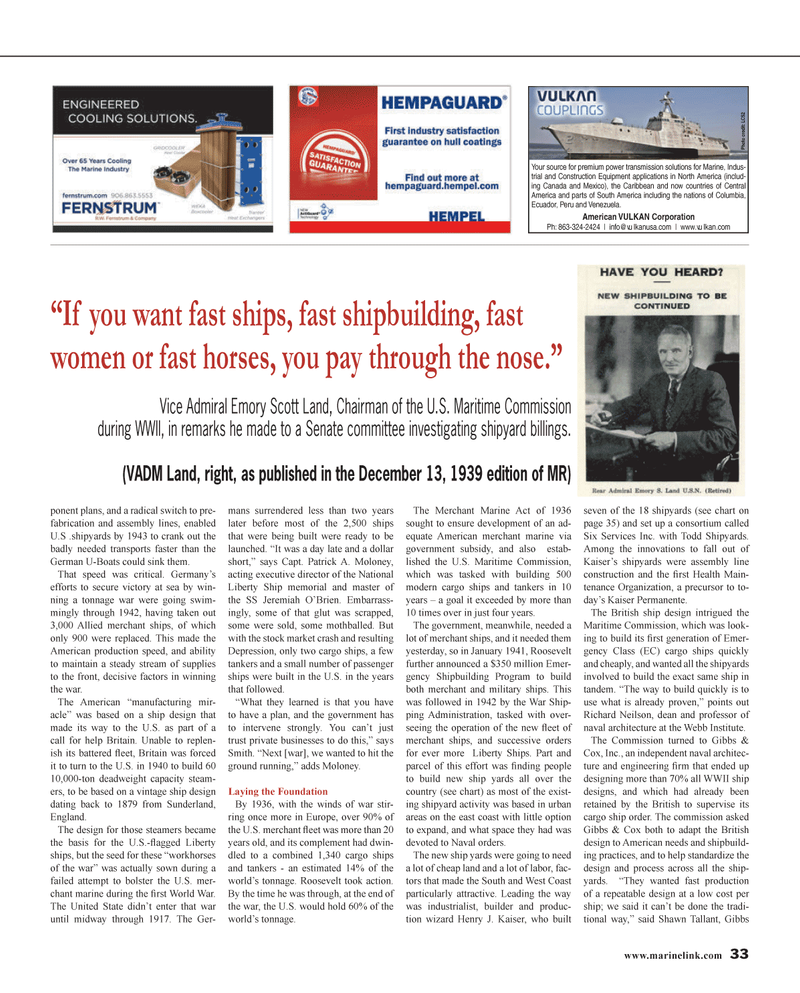
Page 33: of Maritime Reporter Magazine (January 2014)
Ship Repair & Conversion Edition
Read this page in Pdf, Flash or Html5 edition of January 2014 Maritime Reporter Magazine
www.marinelink.com 33 ponent plans, and a radical switch to pre- fabrication and assembly lines, enabled
U.S .shipyards by 1943 to crank out the badly needed transports faster than the
German U-Boats could sink them.
That speed was critical. Germany’s efforts to secure victory at sea by win- ning a tonnage war were going swim- mingly through 1942, having taken out 3,000 Allied merchant ships, of which only 900 were replaced. This made the
American production speed, and ability to maintain a steady stream of supplies to the front, decisive factors in winning the war.
The American “manufacturing mir- acle” was based on a ship design that made its way to the U.S. as part of a call for help Britain. Unable to replen- ish its battered fl eet, Britain was forced it to turn to the U.S. in 1940 to build 60 10,000-ton deadweight capacity steam- ers, to be based on a vintage ship design dating back to 1879 from Sunderland,
England.
The design for those steamers became the basis for the U.S.-fl agged Liberty ships, but the seed for these “workhorses of the war” was actually sown during a failed attempt to bolster the U.S. mer- chant marine during the fi rst World War.
The United State didn’t enter that war until midway through 1917. The Ger- mans surrendered less than two years later before most of the 2,500 ships that were being built were ready to be launched. “It was a day late and a dollar short,” says Capt. Patrick A. Moloney, acting executive director of the National
Liberty Ship memorial and master of the SS Jeremiah O’Brien. Embarrass- ingly, some of that glut was scrapped, some were sold, some mothballed. But with the stock market crash and resulting
Depression, only two cargo ships, a few tankers and a small number of passenger ships were built in the U.S. in the years that followed. “What they learned is that you have to have a plan, and the government has to intervene strongly. You can’t just trust private businesses to do this,” says
Smith. “Next [war], we wanted to hit the ground running,” adds Moloney.
Laying the Foundation
By 1936, with the winds of war stir- ring once more in Europe, over 90% of the U.S. merchant fl eet was more than 20 years old, and its complement had dwin- dled to a combined 1,340 cargo ships and tankers - an estimated 14% of the world’s tonnage. Roosevelt took action.
By the time he was through, at the end of the war, the U.S. would hold 60% of the world’s tonnage.
The Merchant Marine Act of 1936 sought to ensure development of an ad- equate American merchant marine via government subsidy, and also estab- lished the U.S. Maritime Commission, which was tasked with building 500 modern cargo ships and tankers in 10 years – a goal it exceeded by more than 10 times over in just four years.
The government, meanwhile, needed a lot of merchant ships, and it needed them yesterday, so in January 1941, Roosevelt further announced a $350 million Emer- gency Shipbuilding Program to build both merchant and military ships. This was followed in 1942 by the War Ship- ping Administration, tasked with over- seeing the operation of the new fl eet of merchant ships, and successive orders for ever more Liberty Ships. Part and parcel of this effort was fi nding people to build new ship yards all over the country (see chart) as most of the exist- ing shipyard activity was based in urban areas on the east coast with little option to expand, and what space they had was devoted to Naval orders.
The new ship yards were going to need a lot of cheap land and a lot of labor, fac- tors that made the South and West Coast particularly attractive. Leading the way was industrialist, builder and produc- tion wizard Henry J. Kaiser, who built seven of the 18 shipyards (see chart on page 35) and set up a consortium called
Six Services Inc. with Todd Shipyards.
Among the innovations to fall out of
Kaiser’s shipyards were assembly line construction and the fi rst Health Main- tenance Organization, a precursor to to- day’s Kaiser Permanente.
The British ship design intrigued the
Maritime Commission, which was look- ing to build its fi rst generation of Emer- gency Class (EC) cargo ships quickly and cheaply, and wanted all the shipyards involved to build the exact same ship in tandem. “The way to build quickly is to use what is already proven,” points out
Richard Neilson, dean and professor of naval architecture at the Webb Institute.
The Commission turned to Gibbs &
Cox, Inc., an independent naval architec- ture and engineering fi rm that ended up designing more than 70% all WWII ship designs, and which had already been retained by the British to supervise its cargo ship order. The commission asked
Gibbs & Cox both to adapt the British design to American needs and shipbuild- ing practices, and to help standardize the design and process across all the ship- yards. “They wanted fast production of a repeatable design at a low cost per ship; we said it can’t be done the tradi- tional way,” said Shawn Tallant, Gibbs “If you want fast ships, fast shipbuilding, fast women or fast horses, you pay through the nose.”
Vice Admiral Emory Scott Land, Chairman of the U.S. Maritime Commission during WWII, in remarks he made to a Senate committee investigating shipyard billings. (VADM Land, right, as published in the December 13, 1939 edition of MR)
American VULKAN Corporation
Ph : 8 63-324 -24 24 | info@vu lkanusa.com | www.vu lkan.com
Your source for p remium p ower transmission solutions for Marine, Indus- trial and Construction E q uip ment ap p lications in North A merica (includ- ing Canada and Mex ico), th e Caribbean and now countries of Central
A merica and p arts of South A merica including th e nations of Columbia,
E cuador, Peru and V enez uela.
Photo credit: LCS2
MR #1 (32-41).indd 33 1/8/2014 10:08:57 AM

 32
32

 34
34
